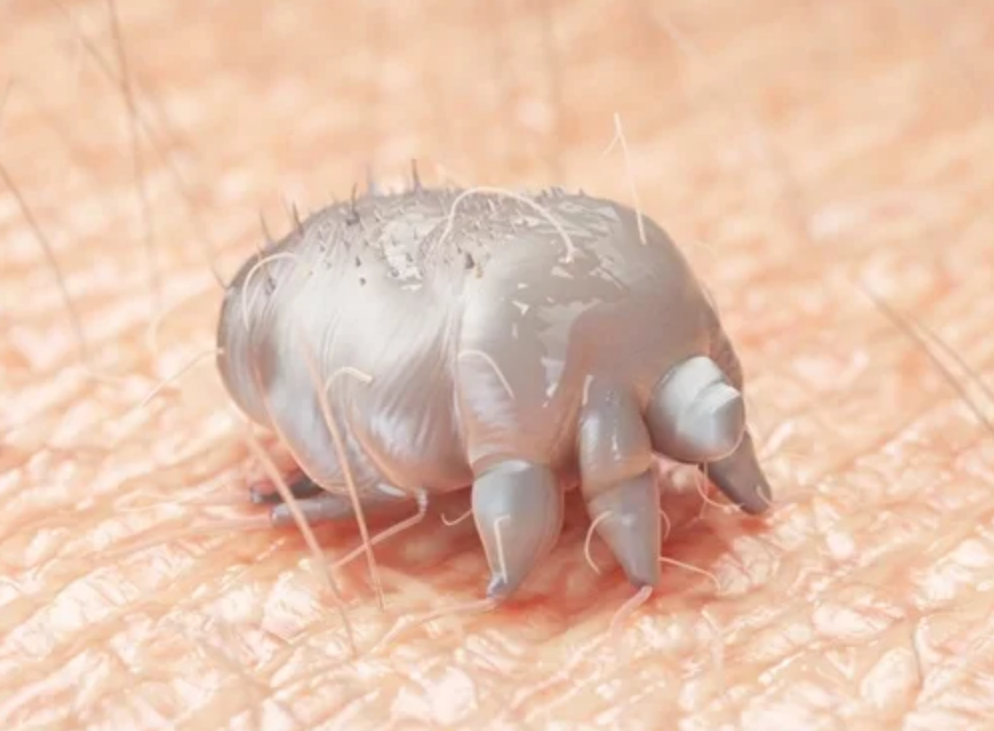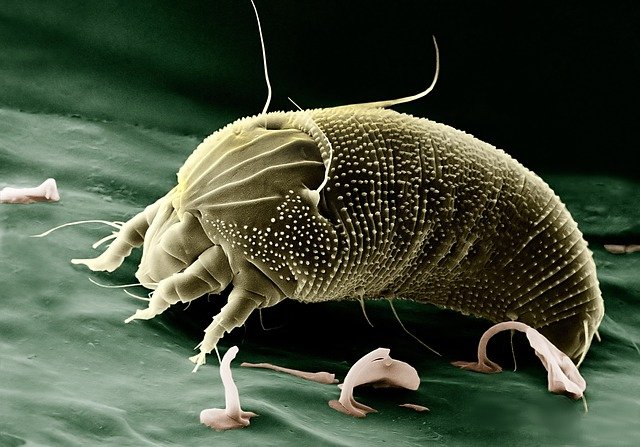
The thought of hundreds or thousands of microscopic mites crawling around you might seem like a nightmare. Unfortunately, that is the reality we live in. Mites normally go about their business unnoticed by humans, but if they start to annoy you, you have to find a way to get rid of them.
The first step to get rid of mites is to find out what type of mite you have. Some mites, like scabies, need the help of a doctor to get rid of them. For household mites, like dust mites, giving your home a deep cleaning will reduce their numbers to the point that they won’t bother you. You can apply pesticides in your home to completely kill off dust mites and stop them from returning. For outdoor mites, such as clover mites, keep vegetation trimmed back from your house.
While the idea of mites is scary, they are simple to manage on your own. To learn more about getting rid of mites, study the rest of this post for some expert tips and details.
I think you may also be interested in reading this related article “How To Get Rid Of Scorpions“.
How To Identify Mites

First, you must be sure which type of mites you want to get rid of. Mites could be one of many different types of insects, and knowing the kind you have helps you get rid of them efficiently and effectively.
Some facts to know about mites are:
- Various tiny insect-like organisms are called mites. They are parasitic insects that can’t be seen by the naked eye.
- A mite goes through four developmental phases:
- Most mites need a host animal to survive, but dust mites can eat flakes of human skin. Mange, demodex and scabies can live on humans and cause irritation, itching and other symptoms.
- Other mites that could affect humans are chiggers, ear mites and spider mites.
- Egg
- Larva
- Nymph
- Adult
Unfortunately, you can’t see mites, making identification difficult. Therefore, you’re going to have to look for signs they leave around your home or the symptoms they cause you and your pets to figure out which ones you have to get rid of.
Where To Look For Mites
Indoors, you might find mites in your furniture, bedding and carpeting. Clover mights usually inhabit lawns, but could also make a home indoors. Dust mites are in nearly every home, living in pillows, mattresses and furniture where they can find plenty of skin flakes and dander to eat.
Because mites are microscopic, you can’t look for them crawling around. Instead, you you can look for signs of mite activity, such as:
- Look for moisture inside your home since mites need it to survive.
- Check that your ventilation system is working to eliminate mite habitats.
- See if there is an accumulation of dust anywhere that could harbor mites.
- Itch mites and scabies live on bodies and will leave you feeling extremely itchy with rashes and bite marks.
- If you notice allergy symptoms when you’re near your bed or furniture, that could be a sign of dust mites.
- Clover mites get smashed by our feet and leave tiny red stains where they die.
Steps For Getting Rid Of Mites
Pesticides aren’t necessary for most mite infestations. Instead, focus on sanitation, heat treatments and vacuuming.
Step 1: Dust, Vacuum and Declutter
Mites require dirty conditions to survive. Therefore, a thorough cleaning is the best method of eliminating mites. A cluttered home harbors more dust and getting rid of unnecessary items makes cleaning easier.
If mites are bothering you, it could be wise to rent a carpet cleaning machine or call in a carpet cleaning service. In some cases, a new carpet could be the best option because there could be pounds of dust hiding under an old carpet.
Use a powerful vacuum to clean all your furniture, mattresses and rugs. Dust mites can burrow deep into furniture and cling to fibers. A professional upholstery cleaning could be the best solution to eliminating a mite infestation.
Step 2: Washing and Heat Treatment
Wash your clothes, bedspreads, pillow cases, pillows and any other fabric you can in 130 degree water. You need to continue washing in 130 degree water until the mite infestation subsides.
Rent a steam cleaner or hire a professional to steam clean your home. Heat is the most effective way to kill mites and steam cleaning doesn’t have any negative health effects for humans.
If mites are on your body, see a dermatologist who can prescribe you medicated soap. Wash your body in a hot shower and follow all your doctor’s instructions.
Step 3: Apply Insecticides
If you want to be sure to kill all of the mites in your home, find an insecticide that is safe to use indoors. Whenever you apply insecticides, be sure to wear personal protective equipment, such as:
- Gloves
- Goggles
- Respirator Mask
- Long Sleeve Clothing
Flex 10-10 is a permethrin and PBO based insecticide labeled to kill mites and is safe for use on upholstery and carpets. It’s a concentrated product that you must mix with water in a spray bottle. You can apply it to any area you suspect to have mites to kill them.
Sterifab is another product that kills mites. You can apply it to any indoor surface. It dries in about 15 minutes, leaving no scent or stains.
Preventing Mites From Returning
After you get rid of mites, some simple maintenance helps to keep them away. Measures you can take to stop mites from re-infesting your home are:
- Seal holes, cracks and crevices around your home to eliminate points of entry for spider mites, chiggers and clover mites.
- Shower after being outdoors for extended periods of time.
- Keep your home clean with regular dusting, vacuuming, laundering and disinfecting surfaces.
- Especially, keep your bed clean by washing your bedding in 130 degree water once per week. Use a dust proof mattress cover to stop mites from moving into your mattress.
- If you continue having mite problems, you should use insecticides once per month or hire a pest control expert to eliminate them with an ongoing treatment.
What Are Mites?
Mites are microscopic arachnids. Mites live on all human bodies and normally don’t cause harm. They can be a problem when their numbers grow too large or if you have an allergy to them.
Dust Mites
A survey of homes in the USA found dust mites in 84% of beds. They are 0.2 to 0.3mm long and translucent, making them impossible to see with the naked eye. Their diet consists of dead skin flakes from humans and other animals.
Dust mite allergy is an allergic reaction to dust mite droppings. It is a common allergy and causes several symptoms, including:
- Asthma
- Eczema
- Itching
Dust mites don’t burrow under skin and aren’t parasitic. They are a nesting species that prefer to live in warm, dark and humid places.
Skin Mites/ Scabies
Some mites can live on your skin and cause severe irritation. Scabies are spread by prolonged skin to skin contact. Symptoms of scabies appear two to six weeks after infection.
The symptoms of scabies include:
- Severe itching or burning skin, especially at night.
- Redness or pimple-like marks.
- Possible burrow marks.
Scabies burrow into your skin to lay eggs. You need to seek medical treatment if you have scabies. They die after three days without a human host or you can wash all your clothes and bedding in 130 degree water to get rid of them.
Spider Mites
Spider mites are a plant pest that lives on the underside of leaves. They feed on plants by puncturing the plant cells, which causes damage. You may have spider mites on your plants if you see a silky webbing under the leaves.
There are several ways to kill spider mites that don’t harm your plants. The best methods for getting rid of spider mites are:
- Neem oil spray repeated over several days or weeks kills spider mites.
- Predatory mites that feed on spider mites can eat five adult spider mites or 20 mite eggs per day.
- Insecticidal soap sprayed on affected plants can help to kill spider mites.
- Harpin alpha beta stimulates the plants natural defenses so they can kill the spider mites on their own.
Clover Mites
These mites are 0.75 to 0.85 mm long and are reddish brown colored. Clover mites are most common in the USA in late spring. They feed on a wide range of plants.
Clover mites often enter homes that are near thick vegetation. Sometimes large numbers of clover mites come into houses through cracks or small openings around windows and doors. They don’t cause harm to humans, but can be annoying because of the red stains they leave when squashed.
You can prevent clover mites from entering your home by trimming back plants from around your home. Treating the perimeter of your home with insecticide kills them before they have a chance to enter.
Mange/ Demodex
Mange is the name of mites that affect pets like dogs and cats. They can spread to human skin, but it’s impossible for them to complete their life cycle on humans. If they do infect a person, they will cause itchiness and skin irritation for a few days until they die.
Signs of mange in animals are hair loss and frequent itching, especially near the ears. Veterinarians can diagnose mange with skin scrapings. Then, they can prescribe a treatment.